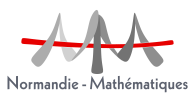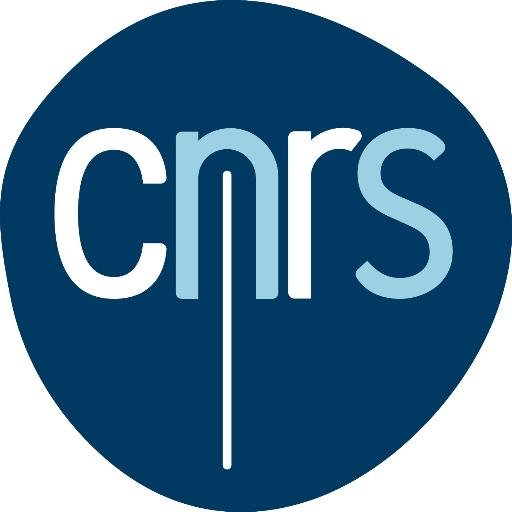Modelling & Numerical Simulation
Workshop@LMI
November 21-22, 2019

Supported by:

Linked to M2SiNum project
![]()

M2SINUM is co-financed by the European Union
with the European regional development fund (ERDF)
and by the Normandie Regional Council.
Organization :
Maria Kazakova and Christian Gout (LMI)
- Program :
Nov. 21 - Morning:
Scientific council meeting - M2SiNuMNov. 21 - Afternoon:15h - 15h30 : Lavdie Rada (Bahçeşehir Üniversitesi, Istanbul, Turkey, invited at LMI by FR CNRS 3335)
Image Segmentation for Intensity Inhomogeneity in Presence of High Noise15h30 - 16h : Antoine Tonnoir (LMI, M2SiNum)
Pymeri : a python code for solving problems from topography to inverse problem
16h-16h30 : Pierre Benard (CORIA, M2SiNum)
Actuator line method applied to grid turbulence generation for large-Eddy simulations
16h30 - 17h : Pause17h - 17h30 : Martin Pierre Schmidt (LMI, M2SiNum)
On structural topology optimization enforcing graded porosity control.
17h30 - 18h : Renata Troian (LMN, M2SiNum)
Shape optimization under vibroacoustic criteriaNov. 22
Scientific meeting M2SINUM (WP 1, 2, 3 and 4).14h30 : Meeting with L.Rada, C. Le Guyader and C. Gout (WP - image processing).16h00 : Talk : G. Khayretdinova, A survey of Image segmentation under geometrical constraints in medical image processing. - Location: Rouen INSA - Bât. Bougainville - Salle 201
Résumés/Abstracts
|
Image Segmentation for Intensity Inhomogeneity in Presence of High Noise L. Rada (BAU) Automated segmentation of fine objects details in a given image is becoming of crucial interest in different imaging fields. In this talk we discuss on new variational level-set model for both global and interactive\ selective segmentation tasks, which can deal with intensity inhomogeneity and the presence of noise. The model utilizes a combination of locally computed denoising constrained surface and a denoising fidelity term to ensure a fine segmentation of local and global features of a given image. A two-phase level set formulation has been extended to a multi-phase formulation to successfully segment medical images of the human brain. Comparative experiments with state of the art models show the advantages of the proposed method.
|
|
PyMERI :a python code for solving problems from topography to inverse problem A. Tonnoir (LMI) The general context of this work is the study of the evolution of the Normandy coast at a local scale. For this purpose, the idea is to coupled topography data with electrical resistivity measurements in order to have a cartography of the subsoil. Electrical Resistivity Imaging (ERI) is a classical method in geophysics that consists in studying the current propagation in the subsoil to image its resistivity (from which we can deduce its properties). In this method, it is essential to precisely take into account the topography of the ground. This topography is constructed thanks to a series of aerial drone photographies and photogrammetry techniques. This leads to a series of xyz coordinates describing the ground. A first work consists then in constructing a Digital Elevation Model (DEM) from these data taking into account the subsoil. This operation (though quite simple) is not classical and not implemented in usual ERI solvers. A second part of the work consists in using this DEM for solving the inverse problem of ERI. A specificity of the developed code PyMERI (Python Modelling Electrical Resistivity Imaging) is to carry out all these operations from DEM construction to inverse problem resolution.
This work is a joint work with Samer Taoum, Yannick Fargier and Cyrille Fauchard.
|
|
Actuator line method applied to grid turbulence generation for large-Eddy simulations P. Bénard (CORIA) The constant growth of computational resources allows nowadays to perform Large-Eddy Simulation (LES) on realistic flow configurations. In this framework, it is important to properly model the turbulence inflow at a low computational cost. This study addresses wind tunnel applications where the object under investigation is downstream of a tur- bulence grid. This grid aims to generate a highly turbulent flow and a sheared velocity profile for further use in wind tur- bines applications. In this work, an original strategy based on the Actuator Line Method (ALM) is proposed to emulate the grid and generate realistic flow structures downstream. The proposed method is compared to usual turbulence injection strategies as well as a geometrical resolution of the turbulence generation grid.
This work is a joint work with Félix Houtin-Mongrolle (CORIA), Laurent Bricteux (UMONS), Ghislain Lartigue (CORIA), Vincent Moureau (CORIA) and Julien Réveillon (CORIA).
|
|
On structural topology optimization enforcing graded porosity control M.-P. Schmidt (LMI) Topology optimization combining Finite Element Analysis (FEA) and numerical sensitivity based optimization schemes for generating optimized structural designs have been around for three decades. Recent technological advances in fabrication techniques like Additive Manufacturing (AM) as well as the increase in available computing power accentuates the interest towards topology optimization for geometrical details and higher resolution structural design results. One example of design freedom brought by AM is the creation of the intricate, robust and lightweight internal structures being the aim of the present study. Our approach builds upon and extends the recent works on topology optimization for the so-called infill structures with a local volume constraint. In order to have more design control over these infill structures, we present a new formulation allowing the generation of mixed design patterns containing bulk and porous regions using guiding constraint parameterizations by non-uniform local volume constraining fields. Secondly, we demonstrate multiple approaches of generating such non-uniform constraint fields to leverage the present formulation and analyze their effect on the geometrical and physical properties of the obtained designs through various numerical experiments.
|
|
Shape optimization under vibroacoustic criteria R. Troian (LMN) This presentation is devoted to the with shape optimization issues under vibroacoustic criteria. The aim of the conducted research is to minimize the energy density in the cavity by changing its geometry parameters.The energy density is obtained through an energy method called simplified energy method (MES). The optimization method is based on a transformation function mapping 3D cavity surface on a 2D domain. The optimization process directly relies on this function and thus avoids remeshing of the geometry. The proposed method allows to describe the geometry through Bezier, Bspline and NURBS parametrization. To illustrate the method, we process a shape optimization on a simple acoustic cavity. |
Maria Kazakova / Christian Gout - Novembre 2019



